- “Schmidt & Maul New York” stamps on neck block, and center strip inside guitar
- X-braced, all original braces inside
- Spanish foot construction
- Radiused Ebony fretboard
- All historically correct bar fret replacement by Steve Kovacik (not too high, and not too thick– correct size bar frets were used, properly finished)
- Original bridge plate, in fine condition
- Original Jerome tuners and buttons
- Original nut, and saddle, in case. New nut and saddle by Steve Kovacik
- Rosette: shares a feature with early Martins– a variant of the "tooth" rosette– a three ring rosette with green "tooth" inner ring, and small "rope" outer rings
- Marquetry Purfling around top, + Maple binding
- Back purfling (backstrip): see Martin Guitars: A Technical Reference, p. 13: this is a “Pre-1867 style 34” Martin style purfling
- Maple binding, back
- Solid Adirondack top
- Solid brazilian rosewood back and sides
- Cedar, Spanish style neck and heel
- Width at lower bout: 12 3/16 inches
- Body length: 18 ¼ inches
- Nut width: 1 15/16 inches
- String spacing at bridge: 2 5/16
- Scale length: 24 ½ inches (But there is a slight compensation: 12th fret to the saddle– Schmidt and Maul added a touch of compensation !
- Original scooped-back ebony bridge
- 100% original finish. No overspray, touch-up, etc. anywhere…wonderful finish
Featured instruments from Vintage American Guitar.
-
Out of stock
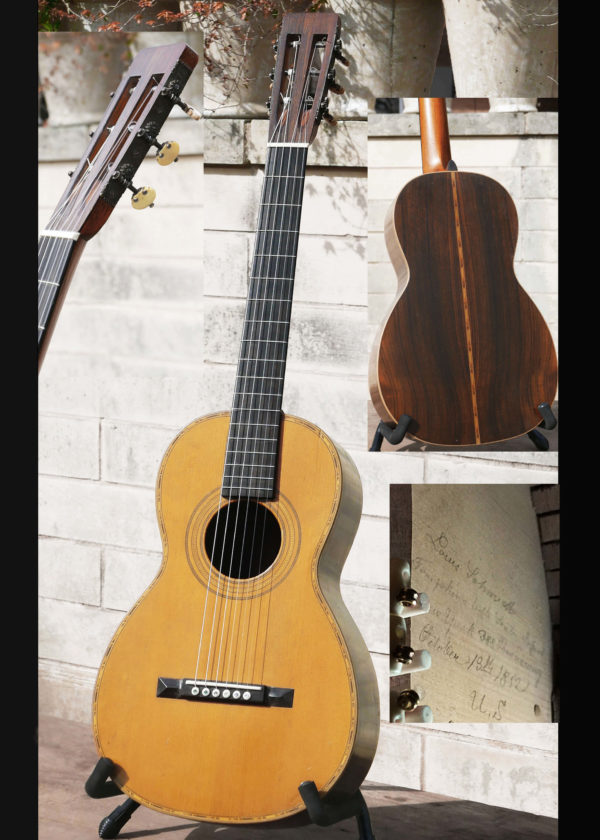 It’s beyond rare to find a guitar from the early Martin – Coupa - Schmidt – Maul – Schatz era in this state of preservation. And one this large. This rare model Schmidt & Maul guitar – by the original C.F. Martin's most famous colleagues and contemporaries– is signed and dated, October 18th, 1852, and is in its original coffin case. And best of all– it plays wonderfully, with low action. A unique piece of American guitar history– not for hanging on the wall but to play. The instrument is signed on the underside of the top: Louis Schmidt Tompkinsville Staten Island New York 388 Broadway October 18th 1852 U.S. This higher end, Spanish neck/heel (not ice-cream cone) Schmidt & Maul is bigger than all the Schmidt & Maul, Schmidt, or George Maul guitars that have come up for sale in the past decades (and not many of any kind have come up for sale). It’s a bit larger than a size 2 Martin, with a width at lower bout of 12 3/16 inches.(Every other Schmidt & Maul that has come to market has been a smaller guitar.) The guitar is braced inside (all original) with an early X-bracing variation similar to the 1953 Schmidt & Maul featured on p. 213 of the book “Inventing the American Guitar– The Pre-Civil War Innovations of C.F. Martin and His Contemporaries” edited by Robert Shaw and Peter Szego. (Hal Leonard Books, 2013). Like the 1853 guitar illustrated in that book, this guitar has bracing on top and back that is very close to the guitar that CF Martin and Schatz made for Madame de Goni. With all original finish, original ebony bridge, and original Jerome tuners– it’s in remarkable condition. To get the best of both worlds– historically authenticity and playability– the guitar has just had a recent neck set, original bridge reglue, and other minor work including new saddle, by one of the country’s top luthiers and authorities for early Martin and early American guitars– Steve Kovacik. All work was done by Steve to historically correct preservation standards after extensive examination and consultation. (Note, in the photo: the picture of the signature inside the guitar: the two cleats are not later repairs– rather they are two center seam-stabilizing cleats put in by the original luthiers in 1852.) Amazingly, this guitar plays in tune up and down the fretboard. Thank the original luthiers at 388 Broadway for that– they had the foresight to add slight compensation (not angled saddle compensation but cheating the saddle back a bit) to the bridge/saddle. Not even CF Martin did that in those years). And thanks to Steve Kovacik for setting this instrument up with low action not ballpark “19th century” action. The Adirondack top is crack-free. Crack-free sides. There are two almost imperceptible cracks on the back– you have to look hard to see them, both addressed by Steve Kovacik.
It’s beyond rare to find a guitar from the early Martin – Coupa - Schmidt – Maul – Schatz era in this state of preservation. And one this large. This rare model Schmidt & Maul guitar – by the original C.F. Martin's most famous colleagues and contemporaries– is signed and dated, October 18th, 1852, and is in its original coffin case. And best of all– it plays wonderfully, with low action. A unique piece of American guitar history– not for hanging on the wall but to play. The instrument is signed on the underside of the top: Louis Schmidt Tompkinsville Staten Island New York 388 Broadway October 18th 1852 U.S. This higher end, Spanish neck/heel (not ice-cream cone) Schmidt & Maul is bigger than all the Schmidt & Maul, Schmidt, or George Maul guitars that have come up for sale in the past decades (and not many of any kind have come up for sale). It’s a bit larger than a size 2 Martin, with a width at lower bout of 12 3/16 inches.(Every other Schmidt & Maul that has come to market has been a smaller guitar.) The guitar is braced inside (all original) with an early X-bracing variation similar to the 1953 Schmidt & Maul featured on p. 213 of the book “Inventing the American Guitar– The Pre-Civil War Innovations of C.F. Martin and His Contemporaries” edited by Robert Shaw and Peter Szego. (Hal Leonard Books, 2013). Like the 1853 guitar illustrated in that book, this guitar has bracing on top and back that is very close to the guitar that CF Martin and Schatz made for Madame de Goni. With all original finish, original ebony bridge, and original Jerome tuners– it’s in remarkable condition. To get the best of both worlds– historically authenticity and playability– the guitar has just had a recent neck set, original bridge reglue, and other minor work including new saddle, by one of the country’s top luthiers and authorities for early Martin and early American guitars– Steve Kovacik. All work was done by Steve to historically correct preservation standards after extensive examination and consultation. (Note, in the photo: the picture of the signature inside the guitar: the two cleats are not later repairs– rather they are two center seam-stabilizing cleats put in by the original luthiers in 1852.) Amazingly, this guitar plays in tune up and down the fretboard. Thank the original luthiers at 388 Broadway for that– they had the foresight to add slight compensation (not angled saddle compensation but cheating the saddle back a bit) to the bridge/saddle. Not even CF Martin did that in those years). And thanks to Steve Kovacik for setting this instrument up with low action not ballpark “19th century” action. The Adirondack top is crack-free. Crack-free sides. There are two almost imperceptible cracks on the back– you have to look hard to see them, both addressed by Steve Kovacik. -
Out of stock
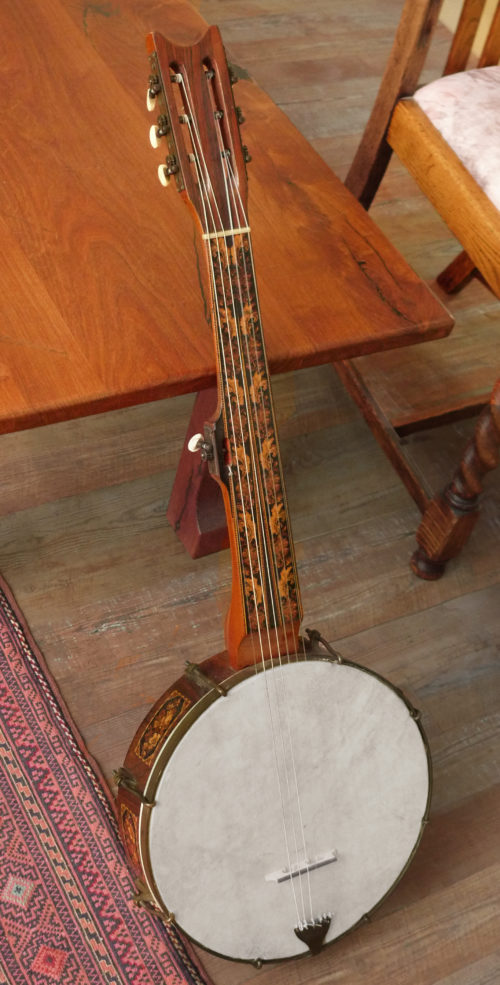 A rare and amazingly original English, Tunbridge ware fretless 7 string banjo. Circa 1850-60. This instrument is 100% original, and even the tailpiece is the original brass tailpiece. This banjo is also rare in that it has original geared tuning machines, not pegs like other examples from the period. The Tunbridge ware banjo is almost impossible to find in this condition and stage of originality. And Tunbridge’s are rare, period. The history? After Joel Sweeney – born to a farming family in Appomattox, Virginia and claimed to have learned to play the banjo from local African population, and the earliest known person to have played the banjo on stage – embarked on a European tour that included stops in London and Edinburgh. He played there for several months, and raised awareness of the instrument in England. As in the U.S., banjos began to be made by local craftsmen – they were still hand made and came in all shapes and sizes, with 5, 6, 7 and even 12 strings, and with one or more drone strings, sometimes on both sides of the neck. Only a few, best ones, such as this instrument, had an amazing amount of work put into them, none more so than those made by a very few firms centered around Tunbridge Wells in Kent, where the local craftsmen specialized in producing a particular form of Treen ware, made from up to 180 different colored woods. Holly, cherry, plum, yew, sycamore, and even imported lignum vitae were all used. The technique was to bind short lengths together and glue them into bundles so when viewed end on, a pattern or picture could be seen. Instrument length: 34 inches. With a 12 inch pot. Eight tensioners and shoes, all original. Original, rare circa 1850 German brass machine tuners (one bent shaft– but still operates perfectly). Original brass tailpiece. Fingerboard, and pot, consisting of inlaid woods as geometric patterns. All the inlays are intact. $2450. In a modern case.
A rare and amazingly original English, Tunbridge ware fretless 7 string banjo. Circa 1850-60. This instrument is 100% original, and even the tailpiece is the original brass tailpiece. This banjo is also rare in that it has original geared tuning machines, not pegs like other examples from the period. The Tunbridge ware banjo is almost impossible to find in this condition and stage of originality. And Tunbridge’s are rare, period. The history? After Joel Sweeney – born to a farming family in Appomattox, Virginia and claimed to have learned to play the banjo from local African population, and the earliest known person to have played the banjo on stage – embarked on a European tour that included stops in London and Edinburgh. He played there for several months, and raised awareness of the instrument in England. As in the U.S., banjos began to be made by local craftsmen – they were still hand made and came in all shapes and sizes, with 5, 6, 7 and even 12 strings, and with one or more drone strings, sometimes on both sides of the neck. Only a few, best ones, such as this instrument, had an amazing amount of work put into them, none more so than those made by a very few firms centered around Tunbridge Wells in Kent, where the local craftsmen specialized in producing a particular form of Treen ware, made from up to 180 different colored woods. Holly, cherry, plum, yew, sycamore, and even imported lignum vitae were all used. The technique was to bind short lengths together and glue them into bundles so when viewed end on, a pattern or picture could be seen. Instrument length: 34 inches. With a 12 inch pot. Eight tensioners and shoes, all original. Original, rare circa 1850 German brass machine tuners (one bent shaft– but still operates perfectly). Original brass tailpiece. Fingerboard, and pot, consisting of inlaid woods as geometric patterns. All the inlays are intact. $2450. In a modern case. -
Out of stock
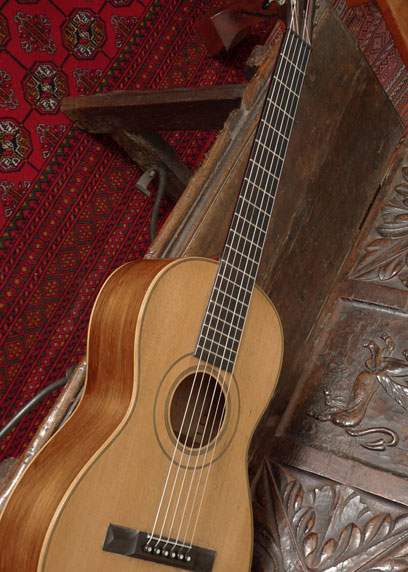 Circa 1860 guitar, style 3 built by well known luthier James Ashborn of Wolcottville, CT, for William Hall & Son music store. Brazilian rosewood back and sides; Adirondack top; maple binding. Rare Brazilian rosewood veneered neck. 100% original, including all original finish, and down to original nut, original bridge (and saddle) that has never been off the guitar. From an article in Vintage Guitar magazine: "Ashborn's design for the guitar was quite innovative for the early 19th century. Instead of making guitars fashioned after the typical parlor-style guitars, he made them in the Spanish style, by taking interior bracing cues from the Spanish while retaining the body of the English guitars. This included a fan brace pattern rather than the more common ladder pattern Ashborn guitars have a very complex dovetail V joint for attaching the head to the neck. The headstock was cut in roughly five steps, using some kind of tracing router, as suggested by the chatter marks on the inside ears of the pegbox. In addition to the complex head design, Ashborn made his own tuning machines in-house. They're made of brass, very much like contemporary machines, with worm gears, cog gears, and rollers. … Ashborn's shop was extremely advanced for its time, having a great deal of know-how and technology. Ashborn understood the need to have the technology as well as the skill, but more importantly he discovered a new way of making high-quality instruments that were affordable. He was able to create a factory environment where workers did what they were good at and, with practice, became very fast and consistent. With a new level of consistency in mass production, he created the path followed by other companies such as Martin, Gibson, and Taylor. Using designs ahead of his time, he was able to bring the sound and change to people who otherwise never would have been able to acquire an instrument of this quality."
Circa 1860 guitar, style 3 built by well known luthier James Ashborn of Wolcottville, CT, for William Hall & Son music store. Brazilian rosewood back and sides; Adirondack top; maple binding. Rare Brazilian rosewood veneered neck. 100% original, including all original finish, and down to original nut, original bridge (and saddle) that has never been off the guitar. From an article in Vintage Guitar magazine: "Ashborn's design for the guitar was quite innovative for the early 19th century. Instead of making guitars fashioned after the typical parlor-style guitars, he made them in the Spanish style, by taking interior bracing cues from the Spanish while retaining the body of the English guitars. This included a fan brace pattern rather than the more common ladder pattern Ashborn guitars have a very complex dovetail V joint for attaching the head to the neck. The headstock was cut in roughly five steps, using some kind of tracing router, as suggested by the chatter marks on the inside ears of the pegbox. In addition to the complex head design, Ashborn made his own tuning machines in-house. They're made of brass, very much like contemporary machines, with worm gears, cog gears, and rollers. … Ashborn's shop was extremely advanced for its time, having a great deal of know-how and technology. Ashborn understood the need to have the technology as well as the skill, but more importantly he discovered a new way of making high-quality instruments that were affordable. He was able to create a factory environment where workers did what they were good at and, with practice, became very fast and consistent. With a new level of consistency in mass production, he created the path followed by other companies such as Martin, Gibson, and Taylor. Using designs ahead of his time, he was able to bring the sound and change to people who otherwise never would have been able to acquire an instrument of this quality." -
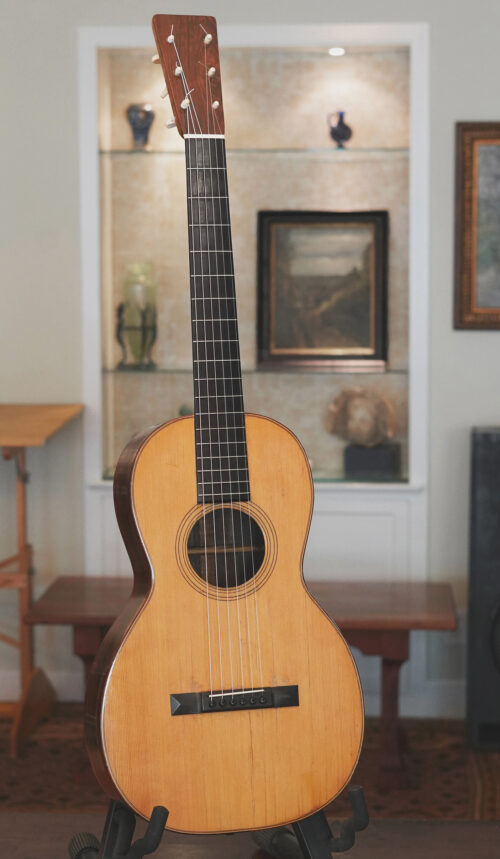
In this period (any Martin guitar made before 1898) there were of course no serial numbers on Martins, and no one signed the instruments inside with a date as they often did in the later 1880’s. But it has all the hallmarks of 1870s to mid-1880’s – and most likely earlier in that period, about 1870, judging by the endstrip material.
It has the original friction tuners – with the exception of the Low E string tuner that was missing and so has been replaced (probably a hundred years ago) with a tuning peg to match the originals.
The size 2 is a great size, it’s a larger guitar than the more common size 2 ½ from this era.
Amazing tone from this guitar. See and hear this guitar being played:
All careful work has been done on this guitar, and it won’t need anything else – it’s a great guitar for the player who wants the best Martin tone and playability – a tonal gem from the 19th century Martin factory in Nazareth.
• Spruce top over Brazilian Rosewood back and sides.
• Spanish heel (not the ice cream cone heel of the less expensive Martins)
• Peg head, with original tuners (with one replacement– the high E string peg)
• Light overspray on top done ages ago, so it’s not very noticeable.
A bit more overspray on back and sides, done decades and decades ago.
• Fan braced – as are most of the best sounding Martins from this era.
• Original thin maple bridge plate
• Original ebony fretboard; Original bar frets with some wear but they’re still pretty high.
• Soft V neck
• Scale length: 24.5 inches
• Width at lower bout: 12 inches
• Nut width: 1 13/16 inch
Multiple cracks on top, all repaired (see photos); multiple cracks on back, all repaired.
Heel has a tiny crack – but it looks like there was never any separation, more of surface crack (see photos)
Two areas by top edge of bridge, either end, where wood was splintered a bit, now repaired and stable. (See photos)
This guitar has seen multiple crack repairs, but it’s structurally sound now, and needs no work going forward. It’s priced low to reflect the work done. It has marvelous sound and projection, and plays with great low action and great intonation all up and down the fretboard. Strung with Savarez Alliance strings.
It would be a great addition to a player wanting a superb example of the best Martin sound from the 19th century – at an affordable cost that’s impossible to find in today’s market.
Ships in a modern hard shell case.
Price: $4,850. – plus shipping
-
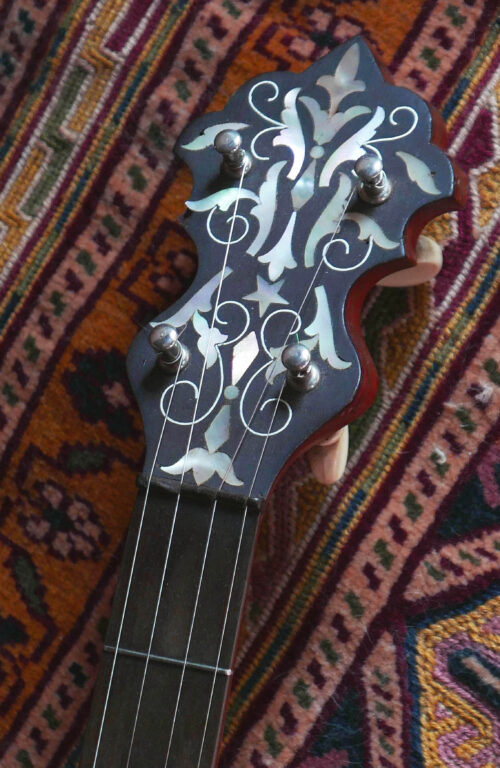 A rare, circa 1895 S.S. Stewart “Special Thoroughbred” 5-string banjo, in original condition. Silver plated pot 5-string neck is cherry Ebony fingerboard Carved heel Mother of pearl headstock inlays, with silver wire inserts also Tone ring is nickel plated on a birds-eye maple pot All of the special logos etc, are still on the inside of the banjo. Condition: amazing, original condition. Does have some wear, but it’s still shiny, and in great condition. (It even has its original leather case, not a very practical case, but original.) Tone is very nice, more focused and loud than the typical turn of the century open-back banjo. Price: $2950.
A rare, circa 1895 S.S. Stewart “Special Thoroughbred” 5-string banjo, in original condition. Silver plated pot 5-string neck is cherry Ebony fingerboard Carved heel Mother of pearl headstock inlays, with silver wire inserts also Tone ring is nickel plated on a birds-eye maple pot All of the special logos etc, are still on the inside of the banjo. Condition: amazing, original condition. Does have some wear, but it’s still shiny, and in great condition. (It even has its original leather case, not a very practical case, but original.) Tone is very nice, more focused and loud than the typical turn of the century open-back banjo. Price: $2950. -
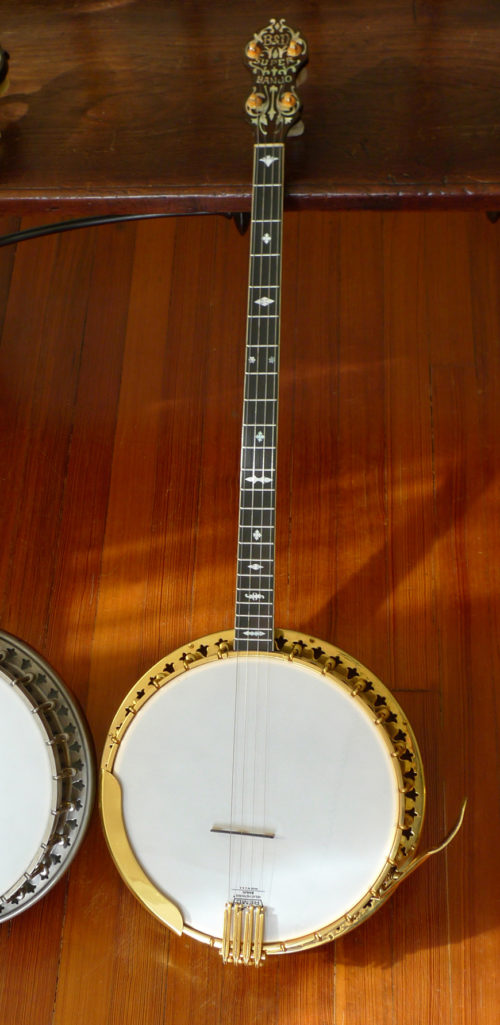 This rare 1926 example of Bacon & Day’s Super, Plectrum banjo is in wonderful condition– collectors quality, but it plays wonderfully. And this is the rare “Super” model A, gold plated. (All original, and with matching serial number on rim and dowel stick.) Original soft pedal stamped "Pat. Pend. B.&D. Soft Pedal." The original gold plating is in great condition, showing extremely little tarnishing, and no thin spots. In fact the banjo shows very little playwear at all. Original plectrum neck, original armrest– in fact all parts are original. Produced in the golden age of Bacon & Day (B&D) production, this banjo was made in Groton, CT. Although the earliest Bacon banjos were produced by various makers for Bacon from 1906-1920, the company’s best era began in 1922 when David Day left the Vega company to partner with Fred Bacon who had begun crafting his instruments in-house in 1920. The B&D banjos produced in this era are of considerably higher quality and are the sought after models by both players and collectors. The photos tell the story. 26 inch scale length. 22 fret plectrum 11″ rim In a recent hard shell case. ... no longer available ...
This rare 1926 example of Bacon & Day’s Super, Plectrum banjo is in wonderful condition– collectors quality, but it plays wonderfully. And this is the rare “Super” model A, gold plated. (All original, and with matching serial number on rim and dowel stick.) Original soft pedal stamped "Pat. Pend. B.&D. Soft Pedal." The original gold plating is in great condition, showing extremely little tarnishing, and no thin spots. In fact the banjo shows very little playwear at all. Original plectrum neck, original armrest– in fact all parts are original. Produced in the golden age of Bacon & Day (B&D) production, this banjo was made in Groton, CT. Although the earliest Bacon banjos were produced by various makers for Bacon from 1906-1920, the company’s best era began in 1922 when David Day left the Vega company to partner with Fred Bacon who had begun crafting his instruments in-house in 1920. The B&D banjos produced in this era are of considerably higher quality and are the sought after models by both players and collectors. The photos tell the story. 26 inch scale length. 22 fret plectrum 11″ rim In a recent hard shell case. ... no longer available ... -
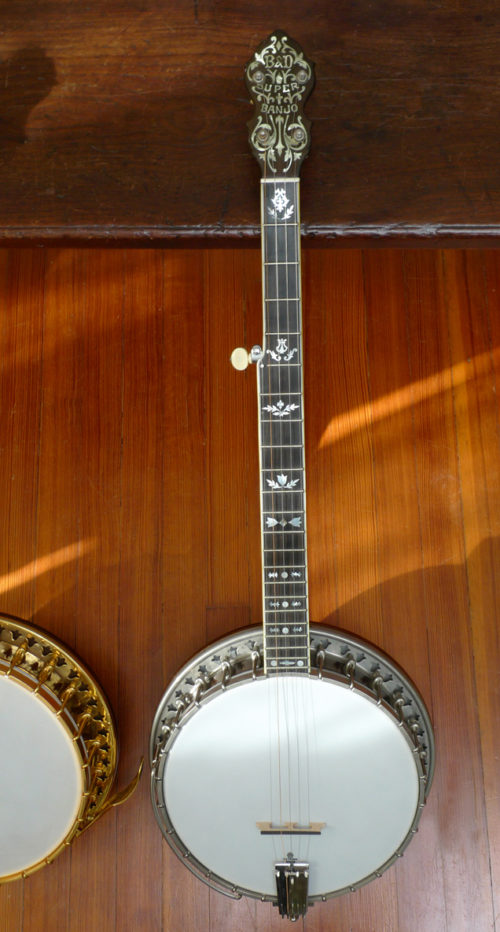 This is a superb sounding 5 string banjo. Quoting George Gruhn in “The Vintage Catalogue”– “During the banjo boom of the 1920s, many musicians considered Bacon & Day to be the finest banjo maker of the time. Their instruments were prized for their exceptional volume and cutting power, as well as for their beautiful craftsmanship… we can only speculate what might have happened if Earl Scruggs, Don Reno, or some other well-known bluegrass player had used a Bacon & Day model.” • Bacon & Day Super, 5-string Banjo (Style A) Serial number: 25892 (early 1928) • Resonator, stamped on inside (in nickel-laminated maple): Bacon Banjo Co., Inc. Groton, CT. U.S.A. Dec. 20th, 1927 • Conversion, 5 string neck (original neck was probably a tenor or plectrum); Presumably, this neck is newer than the banjo– yet the advanced MOP fret markers are as found on the earliest versions of B&D Super banjos. We assume this neck was built by one of the very best U.S. “conversion” builders – with a re-use of the original MOP inlay at the peghead plus the dowel stick. Maple neck, with steel reinforcing rod. Fretboard is beautiful jet-black ebony; multi-layer neck bindings. • 22 frets • Scale length: 27 inches • Extended Maple resonator– nickel laminated on inside • Original flat Tulip-hole flange (not the “add-on” round-hole resonator of earlier years). • Original, top of the line Type III Silver Bell tone ring (No Hole tone ring) original to the instrument (this is the most sought-after, advanced tone ring, introduced early 1927). • Original 2 band Grover geared tuning pegs • Fults tailpiece, and included a variety of Fults tone pins. Bob Fults made the best tailpieces available. And his tone pins let you tweak the tone of your banjo. There are several interchangeable Fults pins included here– ivory, ebony, lead, sterling silver, brass, and copper. Plus a "tone lock". (Bob Fults recently retired, and these highly sought after Fults tailpieces and pins are no longer available.) In its original hard shell case. Price: $3950.
This is a superb sounding 5 string banjo. Quoting George Gruhn in “The Vintage Catalogue”– “During the banjo boom of the 1920s, many musicians considered Bacon & Day to be the finest banjo maker of the time. Their instruments were prized for their exceptional volume and cutting power, as well as for their beautiful craftsmanship… we can only speculate what might have happened if Earl Scruggs, Don Reno, or some other well-known bluegrass player had used a Bacon & Day model.” • Bacon & Day Super, 5-string Banjo (Style A) Serial number: 25892 (early 1928) • Resonator, stamped on inside (in nickel-laminated maple): Bacon Banjo Co., Inc. Groton, CT. U.S.A. Dec. 20th, 1927 • Conversion, 5 string neck (original neck was probably a tenor or plectrum); Presumably, this neck is newer than the banjo– yet the advanced MOP fret markers are as found on the earliest versions of B&D Super banjos. We assume this neck was built by one of the very best U.S. “conversion” builders – with a re-use of the original MOP inlay at the peghead plus the dowel stick. Maple neck, with steel reinforcing rod. Fretboard is beautiful jet-black ebony; multi-layer neck bindings. • 22 frets • Scale length: 27 inches • Extended Maple resonator– nickel laminated on inside • Original flat Tulip-hole flange (not the “add-on” round-hole resonator of earlier years). • Original, top of the line Type III Silver Bell tone ring (No Hole tone ring) original to the instrument (this is the most sought-after, advanced tone ring, introduced early 1927). • Original 2 band Grover geared tuning pegs • Fults tailpiece, and included a variety of Fults tone pins. Bob Fults made the best tailpieces available. And his tone pins let you tweak the tone of your banjo. There are several interchangeable Fults pins included here– ivory, ebony, lead, sterling silver, brass, and copper. Plus a "tone lock". (Bob Fults recently retired, and these highly sought after Fults tailpieces and pins are no longer available.) In its original hard shell case. Price: $3950. -
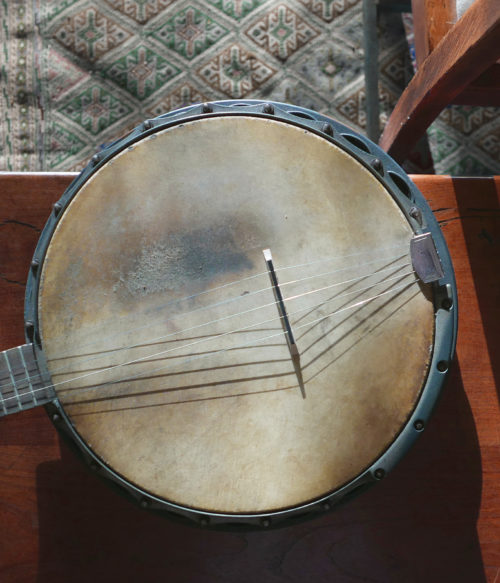 This Banjo has a unique tone, that only comes from a Gretsch Die-cast metal shell/flange construction, prewar banjo. But it’s rare to see these banjos in anything other than tenor. This one is a rare, original 5 string configuration, and has a nice “Gretsch growl” (a term that some drummers use to describe Gretsch drums). Wonderful, dark tone, with bell-like high notes. And with a bit of sustain that is reminiscent of a prewar Dobro guitar. Growl, plus sustain, and ringing highs – only from a Gretsch prewar banjo. Pearloid heastock overlay. 11 inch head. 26 inch scale length. 22-fret Brazilian rosewood fingerboard, with dot markers. Walnut neck, and resonator. Top tension head adjustment with 20 lugs. Original calf skin head. Price: $750.
This Banjo has a unique tone, that only comes from a Gretsch Die-cast metal shell/flange construction, prewar banjo. But it’s rare to see these banjos in anything other than tenor. This one is a rare, original 5 string configuration, and has a nice “Gretsch growl” (a term that some drummers use to describe Gretsch drums). Wonderful, dark tone, with bell-like high notes. And with a bit of sustain that is reminiscent of a prewar Dobro guitar. Growl, plus sustain, and ringing highs – only from a Gretsch prewar banjo. Pearloid heastock overlay. 11 inch head. 26 inch scale length. 22-fret Brazilian rosewood fingerboard, with dot markers. Walnut neck, and resonator. Top tension head adjustment with 20 lugs. Original calf skin head. Price: $750. -
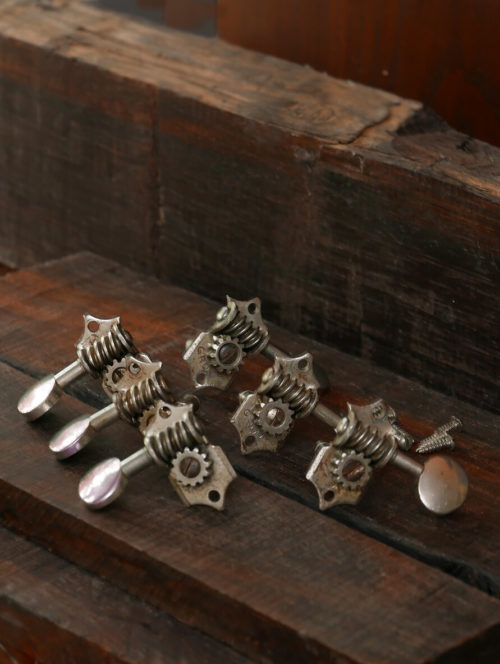 6:1 ratio pre war Grovers, mid-1930's. As used on Martin pre-war dreadoaught guitars. Oval buttons, bevelled edges on the baseplate. Just one button has some missing chrome on one side (see photos). With bushings, and mounting screws. No bent shafts. Good working condition. Price: $795.
6:1 ratio pre war Grovers, mid-1930's. As used on Martin pre-war dreadoaught guitars. Oval buttons, bevelled edges on the baseplate. Just one button has some missing chrome on one side (see photos). With bushings, and mounting screws. No bent shafts. Good working condition. Price: $795. -
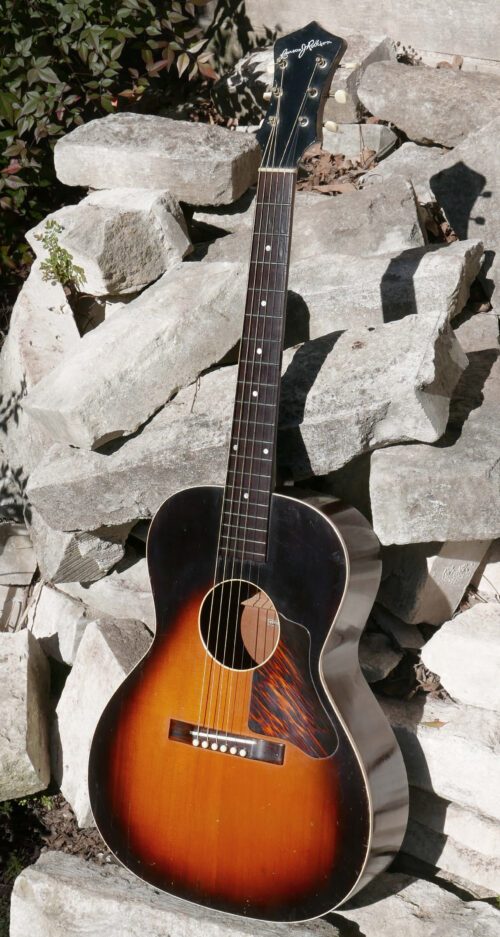 Made in 1937 – it is stamped inside from the Gibson/Kalamazoo factory: “September 1937” • Gibson L-00 (and same as Kalamazoo) body shape with ladder-bracing... all were made in the same Gibson factory. • 24 3/4" Gibson scale length • 1 3/4" nut width • Classic V-shape neck profile, typical of the golden age Gibsons of the mid-1930’s • Adirondack spruce top • Mahogany back and sides • 100% original finish, everywhere • Three hairline cracks on top that are hard to see. (upper bout; bass side near fretboard extension; and below bridge.) They’ve been glued inside. Couple of cracks on back, also have been addressed. Sides are crack-free. • Original Gibson firestripe pick guard • Original tuners (the G string tuner is bent a bit – we prefer to leave it like it is, it works fine, rather than bend it back) • Original Brazilian rosewood bridge, has never been off the guitar. • Brazilian rosewood fingerboard, shows a bit of wear • Original frets, in good condition • Original nut • Original small Maple bridge plate; and all braces inside are original and in great condition. • In a modern hard shell case Price: $3950.
Made in 1937 – it is stamped inside from the Gibson/Kalamazoo factory: “September 1937” • Gibson L-00 (and same as Kalamazoo) body shape with ladder-bracing... all were made in the same Gibson factory. • 24 3/4" Gibson scale length • 1 3/4" nut width • Classic V-shape neck profile, typical of the golden age Gibsons of the mid-1930’s • Adirondack spruce top • Mahogany back and sides • 100% original finish, everywhere • Three hairline cracks on top that are hard to see. (upper bout; bass side near fretboard extension; and below bridge.) They’ve been glued inside. Couple of cracks on back, also have been addressed. Sides are crack-free. • Original Gibson firestripe pick guard • Original tuners (the G string tuner is bent a bit – we prefer to leave it like it is, it works fine, rather than bend it back) • Original Brazilian rosewood bridge, has never been off the guitar. • Brazilian rosewood fingerboard, shows a bit of wear • Original frets, in good condition • Original nut • Original small Maple bridge plate; and all braces inside are original and in great condition. • In a modern hard shell case Price: $3950. -
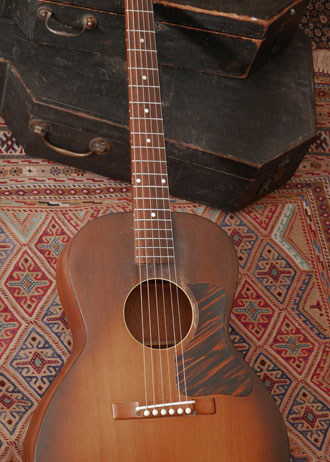 Read the full description below. If you're interested in this guitar, please call 512.922.8596 or contact us here.
Read the full description below. If you're interested in this guitar, please call 512.922.8596 or contact us here. -
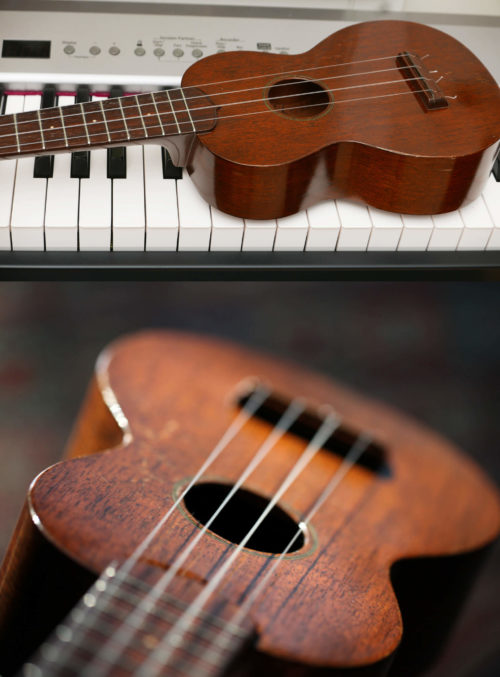 This is great example of Martin’s post war, 1950’s style 0 Ukulele. It has a few nicks and dings, but it’s 100% crack free. And it’s in its original case. It was made between 1957 and 1960 (as indicated by the tuners, and the lack of the “Made in U.S.A.”). Price: $995.
This is great example of Martin’s post war, 1950’s style 0 Ukulele. It has a few nicks and dings, but it’s 100% crack free. And it’s in its original case. It was made between 1957 and 1960 (as indicated by the tuners, and the lack of the “Made in U.S.A.”). Price: $995. -
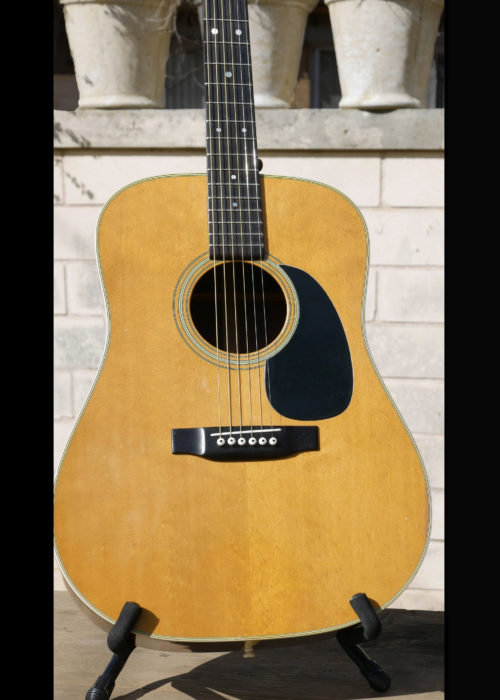 Many players consider the best Martin D-28’s from the 70’s great guitars– and the best value around if you want a vintage D-28 on a budget. The best ones deliver great tone– a darker, richer voice than 50's or 60’s D-28’s. The non-adjustable truss rod, and great Indian rosewood Martin used in those years, and the nice bear claw sitka on top on this example, all make for a lovely instrument. A few nicks and dings, but in remarkable original condition. This instrument delivers. It’s all original, and it’s 100% crack-free (not even the common “pickguard crack”). The original pickguard is not lifting as you often see on these Martins. Original bridge that's never been off the guitar, pins, everything. It has the typical slight finish crazing on top, visible from an angle– it’s common on this vintage. The neck has never been set. Frets in fine shape. Original Grovers. With a low-ish saddle, it plays fine. And in tune everywhere. At some point in the future the new owner may want to do a neck set, but we prefer to keep it all original (and the action is fine as is). ... no longer available – see the newly listed 1970 Martin D-28 in the Featured Instruments section.
Many players consider the best Martin D-28’s from the 70’s great guitars– and the best value around if you want a vintage D-28 on a budget. The best ones deliver great tone– a darker, richer voice than 50's or 60’s D-28’s. The non-adjustable truss rod, and great Indian rosewood Martin used in those years, and the nice bear claw sitka on top on this example, all make for a lovely instrument. A few nicks and dings, but in remarkable original condition. This instrument delivers. It’s all original, and it’s 100% crack-free (not even the common “pickguard crack”). The original pickguard is not lifting as you often see on these Martins. Original bridge that's never been off the guitar, pins, everything. It has the typical slight finish crazing on top, visible from an angle– it’s common on this vintage. The neck has never been set. Frets in fine shape. Original Grovers. With a low-ish saddle, it plays fine. And in tune everywhere. At some point in the future the new owner may want to do a neck set, but we prefer to keep it all original (and the action is fine as is). ... no longer available – see the newly listed 1970 Martin D-28 in the Featured Instruments section. -
Out of stock
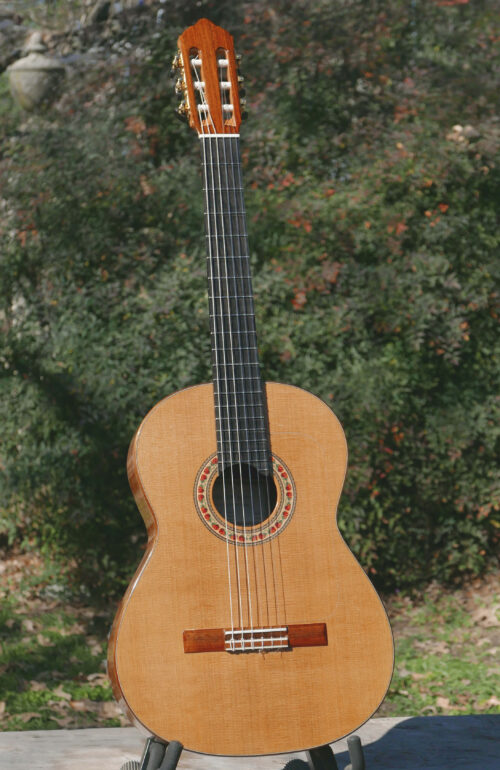 Guitars from the world-renown luthier Lester Devoe are highly sought after – to the extent of a formidable wait list for a new one. And vintage Devoe guitars – especially ones from this era – are hard to come by. So this guitar is a gem. And with close to 30 years of aged wood/tone, its sound is amazing. We’ve had several Devoe's over the years, but none like this one. The age, the fact that it’s a cedar top, its light build, and Lester’s magical touch combine to give this vintage Devoe a tone that is in a class by itself, with both the bold flamenco presence you’d expect, and nuances of color and timbre that many great/expensive classical guitars lack. Like a great classical guitar it responds to the lightest touch, and with deep round rosewood color, yet it’s a lightning storm for flamenco. You can hear/see this guitar in the sound/video clip posted here. https://www.youtube.com/watch?v=4m-M9yI6u9g 1995 Lester Devoe "Flamenco Negra", the term for a Flamenco guitar that has rosewood back and sides. See photo of label.
Guitars from the world-renown luthier Lester Devoe are highly sought after – to the extent of a formidable wait list for a new one. And vintage Devoe guitars – especially ones from this era – are hard to come by. So this guitar is a gem. And with close to 30 years of aged wood/tone, its sound is amazing. We’ve had several Devoe's over the years, but none like this one. The age, the fact that it’s a cedar top, its light build, and Lester’s magical touch combine to give this vintage Devoe a tone that is in a class by itself, with both the bold flamenco presence you’d expect, and nuances of color and timbre that many great/expensive classical guitars lack. Like a great classical guitar it responds to the lightest touch, and with deep round rosewood color, yet it’s a lightning storm for flamenco. You can hear/see this guitar in the sound/video clip posted here. https://www.youtube.com/watch?v=4m-M9yI6u9g 1995 Lester Devoe "Flamenco Negra", the term for a Flamenco guitar that has rosewood back and sides. See photo of label.- Cedar top, and Indian Rosewood back and sides
- Rosewood bridge
- Ebony fretboard
- 650mm scale length
- Sloan tuners
- Clear tap plate treble side
- All original nitrocellulose finish
- Rosette with “roses” design in the classic Andalusia tradition
- Great condition:
-
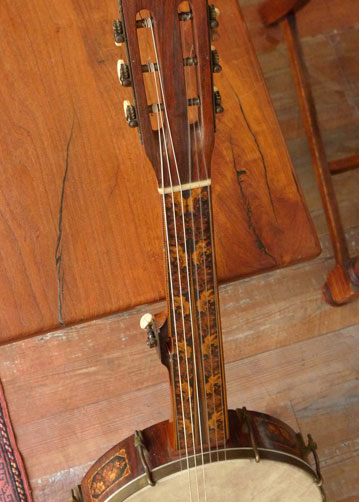 Read the full description below. If you're interested in this guitar, please call 512.922.8596 or contact us here.
Read the full description below. If you're interested in this guitar, please call 512.922.8596 or contact us here. -
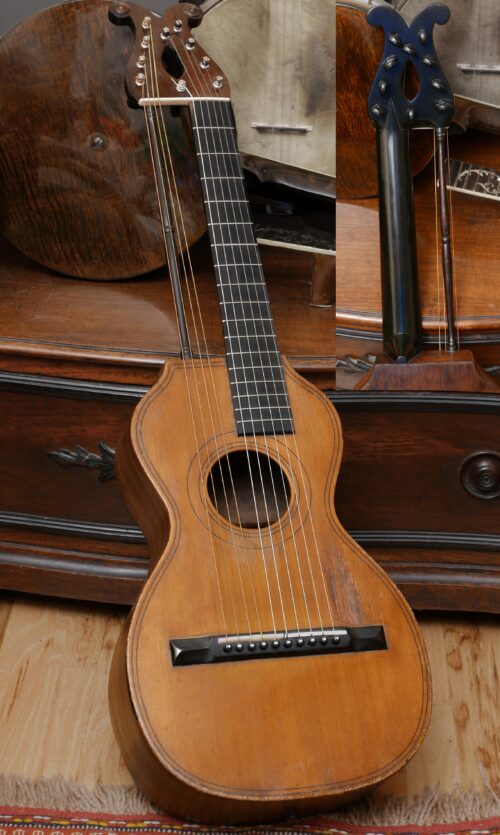 This 10 string harp guitar has no markings no it, i.e. no maker's label, stamp, signature etc. Probably American, likely a one-of-a-kind made by someone we'll never know – but it’s very similar to the 1860 "Renaissance" Martin harp guitar that’s well documented. See/hear the video of this guitar being played: https://www.youtube.com/watch?v=ddxma5gCI7Q 10 string Harp guitar: • Width at lower bout: 12 1/4 inches • It’s deep: 4 ¼ inches at bottom/end pin, 3 /12 deep at neck joint. • Scale length: 24 1/2 inches • Nut width of six-string portion: 1 7/8 inches; string spacing of six strings on the regular guitar portion: 1 ½ inches • Ladder braced – no cracks, bellying, etc, on the original top • Solid Adirondack top, with original finish • Back, and sides: Brazilian rosewood and spruce laminate (similar to some Ashborns, and some Martins from that era). There has been some restoration to the sides, where a few pieces of Brazilian were missing/chipped, as well as to the back (in other words: sections of the outer brazilian layer have been replaced. • Ebony bridge, original. It has been off, and back on • The tuners are modern banjo tuners • Ice cream cone heel, and the neck's been "ebonized". While the neck, fretboard, and head have been restored (recently), the original design is intact. • Neck is Maple – "ebonized" but it's a solid maple neck Price: $6950.
This 10 string harp guitar has no markings no it, i.e. no maker's label, stamp, signature etc. Probably American, likely a one-of-a-kind made by someone we'll never know – but it’s very similar to the 1860 "Renaissance" Martin harp guitar that’s well documented. See/hear the video of this guitar being played: https://www.youtube.com/watch?v=ddxma5gCI7Q 10 string Harp guitar: • Width at lower bout: 12 1/4 inches • It’s deep: 4 ¼ inches at bottom/end pin, 3 /12 deep at neck joint. • Scale length: 24 1/2 inches • Nut width of six-string portion: 1 7/8 inches; string spacing of six strings on the regular guitar portion: 1 ½ inches • Ladder braced – no cracks, bellying, etc, on the original top • Solid Adirondack top, with original finish • Back, and sides: Brazilian rosewood and spruce laminate (similar to some Ashborns, and some Martins from that era). There has been some restoration to the sides, where a few pieces of Brazilian were missing/chipped, as well as to the back (in other words: sections of the outer brazilian layer have been replaced. • Ebony bridge, original. It has been off, and back on • The tuners are modern banjo tuners • Ice cream cone heel, and the neck's been "ebonized". While the neck, fretboard, and head have been restored (recently), the original design is intact. • Neck is Maple – "ebonized" but it's a solid maple neck Price: $6950. -
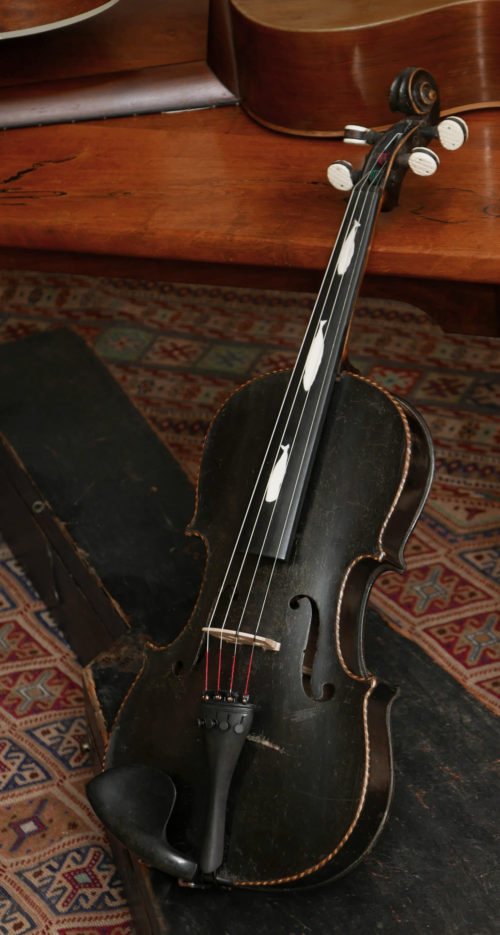 This full-size violin, is a wonderful example of New England whaler culture of the 19th century. The violin itself is probably German made, early 1800’s, with maple back and sides. But the whale inlays (bone) on the fingerboard were no doubt done locally in New England. And the custom, hand made wood case, original to the instrument, also features a brass whale on the top. (Note, the brass handle on the case, is the exact kind used by CF Martin on their coffin cases for guitars in the mid-19th century.) The bridge, and tailpiece are modern. Bone inlays on the tuning pegs also. The instrument is fully set up and ready to play. Price: $2150. In its original wood case, with a brass whale inlay on top.
This full-size violin, is a wonderful example of New England whaler culture of the 19th century. The violin itself is probably German made, early 1800’s, with maple back and sides. But the whale inlays (bone) on the fingerboard were no doubt done locally in New England. And the custom, hand made wood case, original to the instrument, also features a brass whale on the top. (Note, the brass handle on the case, is the exact kind used by CF Martin on their coffin cases for guitars in the mid-19th century.) The bridge, and tailpiece are modern. Bone inlays on the tuning pegs also. The instrument is fully set up and ready to play. Price: $2150. In its original wood case, with a brass whale inlay on top. -
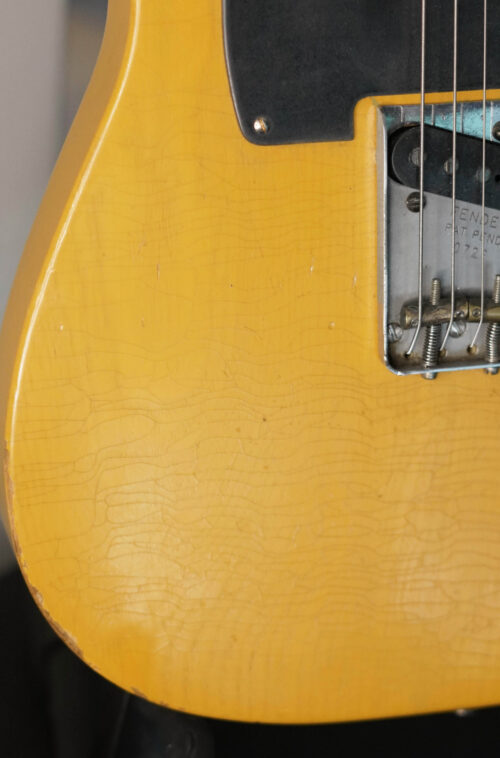 52 Broadcaster. Impeccable attention to detail. Great sound, and feel. No, it never left the Fullerton factory as you see it here. This is one of the best tribute builds you'll find, at any price, done by real players. You can spend $6K plus, on a recent Fender Custom Shop version, but it won't look this good and it won't play like this. The best nitro cellulose finish, with light relic, and crazing. MJT body. Warmoth Fender licensed birds eye maple neck, chunky C-shape. Duncan Antiquity pickups. The bridge– with the numbers you see– is not available on a "Custom Shop" or reissue. It was custom made and on the instrument when we acquired it. Price: $3750. Ships in a well-worn modern tele case.
52 Broadcaster. Impeccable attention to detail. Great sound, and feel. No, it never left the Fullerton factory as you see it here. This is one of the best tribute builds you'll find, at any price, done by real players. You can spend $6K plus, on a recent Fender Custom Shop version, but it won't look this good and it won't play like this. The best nitro cellulose finish, with light relic, and crazing. MJT body. Warmoth Fender licensed birds eye maple neck, chunky C-shape. Duncan Antiquity pickups. The bridge– with the numbers you see– is not available on a "Custom Shop" or reissue. It was custom made and on the instrument when we acquired it. Price: $3750. Ships in a well-worn modern tele case. -
Out of stock
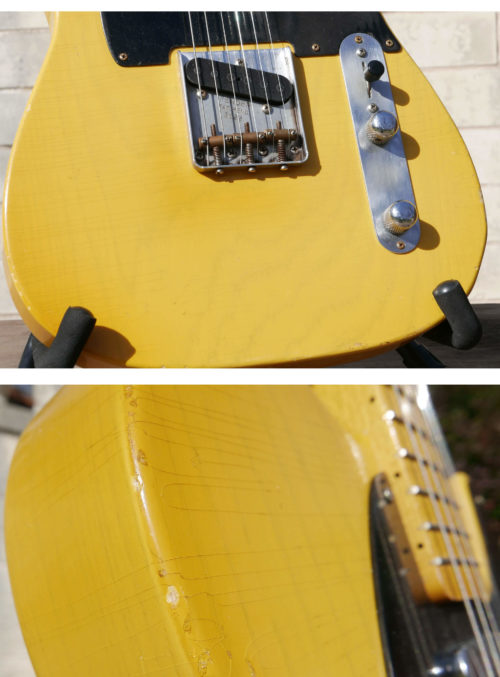 This could be the best blackguard telecaster tribute ever. An homage to the great early 50’s telecaster. But it only gets accolades if it’s a great player. This one is a great player–its light weight (same weight range as on original early 50s telecaster), pickups, setup, and attention to detail make for a great sounding tele. A joy to play. There appear to be a few original 1952/1953 parts on this guitar– but this guitar is being offered strictly as a reproduction/tribute. And it’s a tribute, in its way, to the art of the (great) copy– and on that note, it comes with Nacho Baños’ great book, The Blackguard book (out of print and a $300-400 value in itself), with matching serial number on the cover of the book. (Click here for a story on Baños.) So the purchaser can follow along the narrative of some of the great original early Blackguards in the book–and how to identify original early 50’s Telecaster, Nocaster, and Esquire elements and parts– while having fun with this intriguing tribute guitar. • The bridge, a good reproduction of unknown origin. The photos tell the story. (Original early 50’s brass saddles?). Reproduction tuners. • The pickguard looks convincing, but we're calling it a reproduction. • Seymour Duncan Antiquity pickups. • The pots, and the pickup switch, appear to be original 1952 or 1953 Fender parts (but not with original solder joints etc). • The control plate appears to be an original 1952/1953 Fender plate. Tone, volume knobs are (good) reproductions. • Neck is from Mark Jenny, stamped on heel as official Fender “Licensed” neck. Medium C profile. Great feel– not baseball bat, and not too thin. • Weight, with strings: 6.625 lbs. This is in the same weight range as original early 50s telecasters. Compare to the weight of mediocre telecaster “reissues” on the market today, all of which weigh much more. • The body is by Mark Jenny. We waited patiently for over a year until the right Jenny body became available, to complete this instrument in the best way possible and to remove from the market the (nice light weight) reproduction body that was in place when we acquired the guitar that had a non-authentic 1952 date and signature in the neck pocket. The right thing to do– and the Mark Jenny body in place now has crazing and other elements characteristic to the early blackguard look, weight, wear, and feel. • Set up perfectly, and ready to play. Sold as a reproduction/tribute guitar only, together with the Nacho Baños The Blackguard book (book in as-new condition in original box) that will school the new owner on how to evaluate the fine, fully pedigreed, great Blackguards of the early 50’s. Price: $5950.
This could be the best blackguard telecaster tribute ever. An homage to the great early 50’s telecaster. But it only gets accolades if it’s a great player. This one is a great player–its light weight (same weight range as on original early 50s telecaster), pickups, setup, and attention to detail make for a great sounding tele. A joy to play. There appear to be a few original 1952/1953 parts on this guitar– but this guitar is being offered strictly as a reproduction/tribute. And it’s a tribute, in its way, to the art of the (great) copy– and on that note, it comes with Nacho Baños’ great book, The Blackguard book (out of print and a $300-400 value in itself), with matching serial number on the cover of the book. (Click here for a story on Baños.) So the purchaser can follow along the narrative of some of the great original early Blackguards in the book–and how to identify original early 50’s Telecaster, Nocaster, and Esquire elements and parts– while having fun with this intriguing tribute guitar. • The bridge, a good reproduction of unknown origin. The photos tell the story. (Original early 50’s brass saddles?). Reproduction tuners. • The pickguard looks convincing, but we're calling it a reproduction. • Seymour Duncan Antiquity pickups. • The pots, and the pickup switch, appear to be original 1952 or 1953 Fender parts (but not with original solder joints etc). • The control plate appears to be an original 1952/1953 Fender plate. Tone, volume knobs are (good) reproductions. • Neck is from Mark Jenny, stamped on heel as official Fender “Licensed” neck. Medium C profile. Great feel– not baseball bat, and not too thin. • Weight, with strings: 6.625 lbs. This is in the same weight range as original early 50s telecasters. Compare to the weight of mediocre telecaster “reissues” on the market today, all of which weigh much more. • The body is by Mark Jenny. We waited patiently for over a year until the right Jenny body became available, to complete this instrument in the best way possible and to remove from the market the (nice light weight) reproduction body that was in place when we acquired the guitar that had a non-authentic 1952 date and signature in the neck pocket. The right thing to do– and the Mark Jenny body in place now has crazing and other elements characteristic to the early blackguard look, weight, wear, and feel. • Set up perfectly, and ready to play. Sold as a reproduction/tribute guitar only, together with the Nacho Baños The Blackguard book (book in as-new condition in original box) that will school the new owner on how to evaluate the fine, fully pedigreed, great Blackguards of the early 50’s. Price: $5950. -
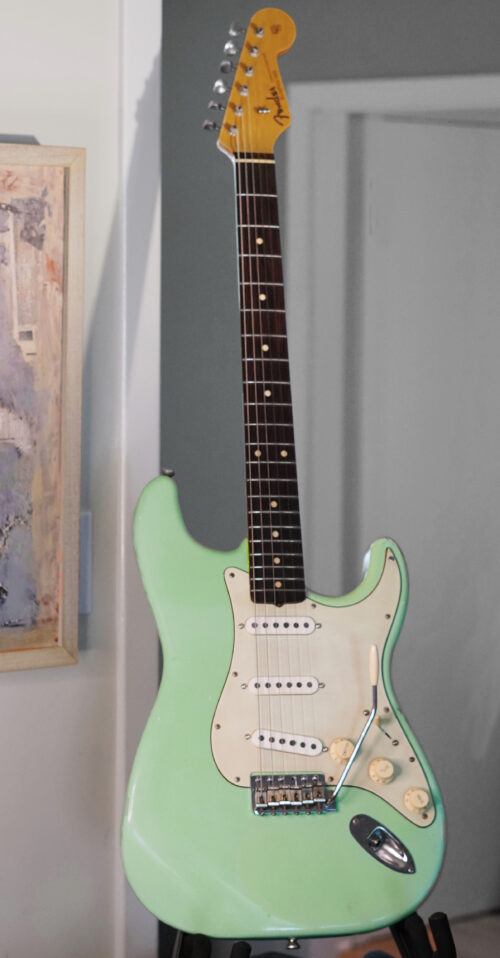 63 Surf Green Strat tribute. Impeccable attention to detail. And more importantly, the right sound, and feel. It never left the Fullerton factory as you see it here – it’s a great tribute build that not only looks right, it plays like a dream. Loud and resonant, even when not plugged in. You can spend $6K plus, on a recent Fender Custom Shop versions, but it won't look this good and it won't play like this. Thin nitro cellulose finish, with light relic. Klein pickups, the choice of players who need the best authentic sound. Includes many Fender licensed parts, that makes it legit on the market. Strat is '63 spec, and note it has a chunky neck. Surf Green is as it should be, with the just a tiny touch of yellowy tint in places on guitar top, as what happens to a true vintage Surf Green finish after years of fading. Price: $3650. Ships in a well-used modern strat case.
63 Surf Green Strat tribute. Impeccable attention to detail. And more importantly, the right sound, and feel. It never left the Fullerton factory as you see it here – it’s a great tribute build that not only looks right, it plays like a dream. Loud and resonant, even when not plugged in. You can spend $6K plus, on a recent Fender Custom Shop versions, but it won't look this good and it won't play like this. Thin nitro cellulose finish, with light relic. Klein pickups, the choice of players who need the best authentic sound. Includes many Fender licensed parts, that makes it legit on the market. Strat is '63 spec, and note it has a chunky neck. Surf Green is as it should be, with the just a tiny touch of yellowy tint in places on guitar top, as what happens to a true vintage Surf Green finish after years of fading. Price: $3650. Ships in a well-used modern strat case. -
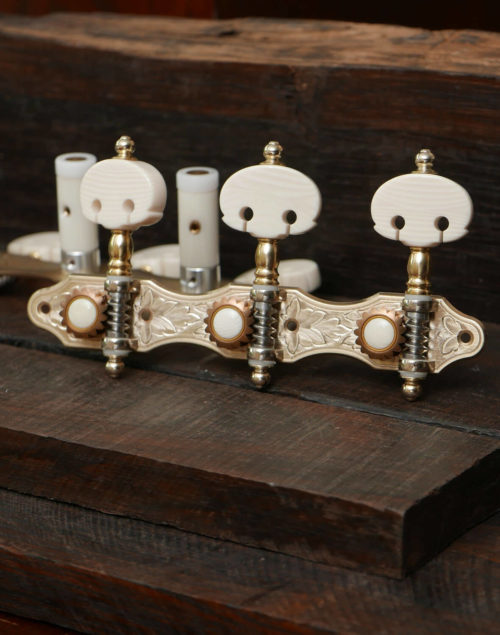 Alessi, Hauser style machine head tuners. More rare, deep silver plating. Hand made in Italy. Engraved with high detail. These are new, old stock. Made circa 2009, they have never been used or mounted on a guitar, and they come with the original mounting screws, and in their original wood presentation case. Synthetic ivory kidney shaped buttons (rare style). 35mm on center. Perfect, unused condition. Price: $895.
Alessi, Hauser style machine head tuners. More rare, deep silver plating. Hand made in Italy. Engraved with high detail. These are new, old stock. Made circa 2009, they have never been used or mounted on a guitar, and they come with the original mounting screws, and in their original wood presentation case. Synthetic ivory kidney shaped buttons (rare style). 35mm on center. Perfect, unused condition. Price: $895. -
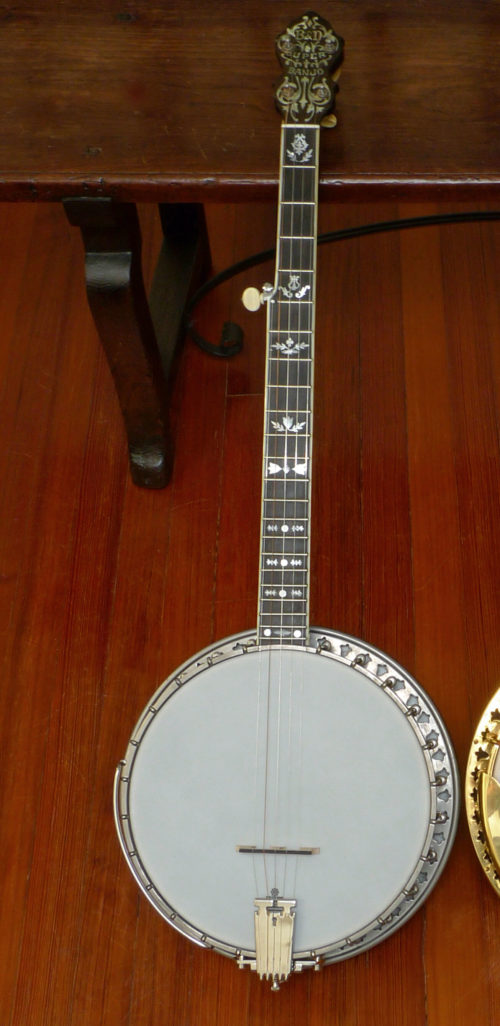 This is a superb sounding 5 string banjo. Original nickel plating. • Bacon & Day Super, 5-string Banjo (Style A) Serial number: 25892 (early 1928) • Resonator, stamped on inside (in nickel-laminated maple): Bacon Banjo Co., Inc. Groton, CT. U.S.A. Dec. 20th, 1927 • Conversion, 5 string neck (original neck was probably a tenor or plectrum); Presumably, this neck is newer than the banjo– yet the advanced MOP fret markers are as found on the earliest versions of B&D Super banjos. We assume this neck was built by one of the best U.S. “conversion” builders – with a re-use of the original MOP inlay at the peghead plus the dowel stick. Maple neck, with steel reinforcing rod. Fretboard is beautiful jet-black ebony; multi-layer neck bindings. Fretboard is a very comfortable 1 3/8 inches wide at the nut, 1 7/8 wide where fretboard meets body. • Nickel plated • 22 frets • Scale length: 27 inches • Extended Maple resonator– nickel laminated on inside • Original flat Tulip-hole flange (not the “add-on” round-hole resonator of earlier years). • Original, top of the line Type III Silver Bell tone ring (No Hole tone ring) original to the instrument (this is the most sought-after, advanced Silver Bell tone ring, introduced early 1927). • Original 2 band Grover geared tuning pegs • Fults tailpiece, and included a variety of Fults tone pins. Bob Fults made the best tailpieces available. And his tone pins let you tweak the tone of your banjo. There are several interchangeable Fults pins included here– ivory, ebony, lead, sterling silver, brass, and copper. Plus a “tone lock”. (Bob Fults recently retired, and these highly sought after Fults tailpieces and pins are no longer available.) In its original hard shell Lifton case. $3750.
This is a superb sounding 5 string banjo. Original nickel plating. • Bacon & Day Super, 5-string Banjo (Style A) Serial number: 25892 (early 1928) • Resonator, stamped on inside (in nickel-laminated maple): Bacon Banjo Co., Inc. Groton, CT. U.S.A. Dec. 20th, 1927 • Conversion, 5 string neck (original neck was probably a tenor or plectrum); Presumably, this neck is newer than the banjo– yet the advanced MOP fret markers are as found on the earliest versions of B&D Super banjos. We assume this neck was built by one of the best U.S. “conversion” builders – with a re-use of the original MOP inlay at the peghead plus the dowel stick. Maple neck, with steel reinforcing rod. Fretboard is beautiful jet-black ebony; multi-layer neck bindings. Fretboard is a very comfortable 1 3/8 inches wide at the nut, 1 7/8 wide where fretboard meets body. • Nickel plated • 22 frets • Scale length: 27 inches • Extended Maple resonator– nickel laminated on inside • Original flat Tulip-hole flange (not the “add-on” round-hole resonator of earlier years). • Original, top of the line Type III Silver Bell tone ring (No Hole tone ring) original to the instrument (this is the most sought-after, advanced Silver Bell tone ring, introduced early 1927). • Original 2 band Grover geared tuning pegs • Fults tailpiece, and included a variety of Fults tone pins. Bob Fults made the best tailpieces available. And his tone pins let you tweak the tone of your banjo. There are several interchangeable Fults pins included here– ivory, ebony, lead, sterling silver, brass, and copper. Plus a “tone lock”. (Bob Fults recently retired, and these highly sought after Fults tailpieces and pins are no longer available.) In its original hard shell Lifton case. $3750. -
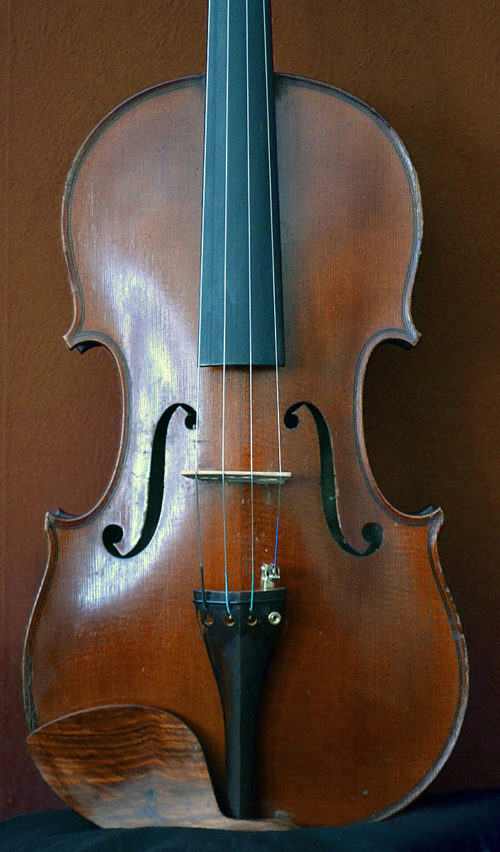 Full size, Charles Fetique violin (French, early 20th century – circa 1930), with original label inside. This is a rich, sonorous instrument. A deep, round tone, that – like all good violins – does not make you work overly hard to attain. It has a darker, lush, round tone that professional players love – and great projection. We recently A-B'd this instrument against $5k+ violins in the area, and there was no comparison, this instrument was louder, more full, more round and full in the bass notes, and all around a stellar performer. This violin would be a great student violin upgrade – for that aspiring violinist who is ready to graduate to, and enjoy, a better instrument than what's typically available in the $4-5K range, at a very attractive price. And, the buyer will have the confidence of both a Letter of Expertise, and a professional appraisal: • Certificate: Jean-Jacques Rampal, Paris, 2014. (This is the letter of expertise, on this violin, from one of the top experts on French Violins, in Paris, France). And: • Written, professional appraisal of the violin, done from personal inspection, from one of the top violin shops/experts in Texas (Jay R. Rury Violins, Dallas), with a valuation of $3,500.00 Both the above documents will be included with the sale. The violin is in excellent condition. There are no sound post, or bass bar cracks. It was professionally set up to play, by Blackerby Violin in Austin. In a modern Tonerelli case. Price: $3250.
Full size, Charles Fetique violin (French, early 20th century – circa 1930), with original label inside. This is a rich, sonorous instrument. A deep, round tone, that – like all good violins – does not make you work overly hard to attain. It has a darker, lush, round tone that professional players love – and great projection. We recently A-B'd this instrument against $5k+ violins in the area, and there was no comparison, this instrument was louder, more full, more round and full in the bass notes, and all around a stellar performer. This violin would be a great student violin upgrade – for that aspiring violinist who is ready to graduate to, and enjoy, a better instrument than what's typically available in the $4-5K range, at a very attractive price. And, the buyer will have the confidence of both a Letter of Expertise, and a professional appraisal: • Certificate: Jean-Jacques Rampal, Paris, 2014. (This is the letter of expertise, on this violin, from one of the top experts on French Violins, in Paris, France). And: • Written, professional appraisal of the violin, done from personal inspection, from one of the top violin shops/experts in Texas (Jay R. Rury Violins, Dallas), with a valuation of $3,500.00 Both the above documents will be included with the sale. The violin is in excellent condition. There are no sound post, or bass bar cracks. It was professionally set up to play, by Blackerby Violin in Austin. In a modern Tonerelli case. Price: $3250. -
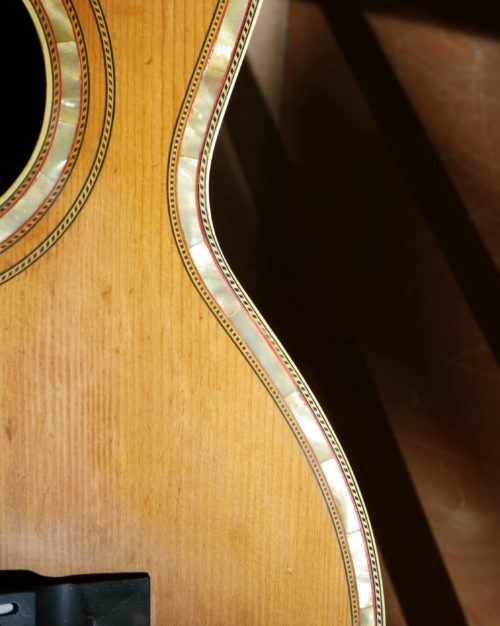 Circa 1912 Mother of Pearl Inlaid Guitar The guitar is extensively inlayed with mother of pearl . The guitar was restored in 2001, work that included converting the instrument to X-bracing, reproduction ebony bridge, reproduction small maple bridge plate. It’s signed inside by the restorer, “B. Lehmann 2001” (Bernie Lehmann, well known luthier in New York.) The guitar has no stamps or labels, but it was probably made by George Bauer – because of many stylistic similarities. The guitar is set up and ready to play. As many guitars of this era, the tone is tilted toward very bright, glassy, brazilian rosewood trebles, not fuller bass. Solid Spruce top Solid Brazilian Rosewood back and sides MOP inlays, fretboard, rosette, and bindings X-braced Original tuners Width at lower bout: 13 1/2 inches Scale Length: 24 7/8 inches Nut Width: 1 ¾ inches V shaped neck .... no longer available....
Circa 1912 Mother of Pearl Inlaid Guitar The guitar is extensively inlayed with mother of pearl . The guitar was restored in 2001, work that included converting the instrument to X-bracing, reproduction ebony bridge, reproduction small maple bridge plate. It’s signed inside by the restorer, “B. Lehmann 2001” (Bernie Lehmann, well known luthier in New York.) The guitar has no stamps or labels, but it was probably made by George Bauer – because of many stylistic similarities. The guitar is set up and ready to play. As many guitars of this era, the tone is tilted toward very bright, glassy, brazilian rosewood trebles, not fuller bass. Solid Spruce top Solid Brazilian Rosewood back and sides MOP inlays, fretboard, rosette, and bindings X-braced Original tuners Width at lower bout: 13 1/2 inches Scale Length: 24 7/8 inches Nut Width: 1 ¾ inches V shaped neck .... no longer available....